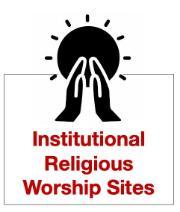
Institutional religious worship sites, often called “houses of worship” or “places of worship,” are specially designed structures for formal and informal gatherings of affiliates of particular religious traditions for religious rituals, rites, religious study, and other activities that fall under the authority of an organized religious body with official bureaucratic leadership structures; codified rules and practices; and systematized dogma and doctrinal teachings. Such sites include Christian basilicas, cathedrals, churches, and chapels; Sikh gurdwaras; Muslim mosques; Jewish synagogues; Buddhist, Hindu, or Jain temples; and Mormon or Quaker meeting houses.
A group that meets at an institutional religious site is referred to as a “congregation,” and the congregants often share an identity and a sense of belonging to the congregation as a “community.” While some congregations are independent, others belong to another institutional religious form called a “denomination,” which is a larger umbrella or governing organization. Examples of denominations include Conservative and Reform Judaism or Roman Catholic and Presbyterian Christianity.
Though institutional religion is often considered the only form of religion, it is but one of the many forms of religion explored in this section. Still, institutional religion is the most recognizable form of religion. Typically, it unfolds in a particular place, or site. But not always. A house of worship is an institutional religious site in which people practice various forms of religion. But people also practice institutional forms of religion—reciting prayers, displaying symbols or images, observing dietary rules associated with specific religions— in their homes, workplaces, schools, and other everyday places beyond formal houses of worship.
The architecture of institutional religious worship sites typically expresses elements of the beliefs, cultures, histories, economic status, and technological capabilities of those who build or adapt them. Institutional worship sites are protected from being fired upon during armed conflict and war under International Humanitarian Law and the Geneva Conventions, so they often serve as sanctuaries for those under siege. While cultural customs mark houses of worship as sanctuaries for those fleeing violence, persecution, deportation, or arrest, the historical tradition of allowing sanctuary in churches was abolished in England in 1623 and did not become a formal feature under U.S. law.